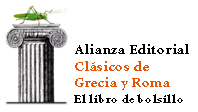La corona no hace al rey: la creación de la imagen del nuevo AugustoCrown does not make the king: developing the image of the new Augustus
Elena Miramontes Seijas
Resumen
La cuidadosa selección, por parte de Octaviano, de los títulos que aceptaría del senado, le permitieron hacerse de facto con el poder absoluto, aquel que un día habían ostentado los antiguos reyes, sin necesidad de ser asociado oficialmente con los poderes absolutistas de la extinta monarquía ni de los gobernantes orientales.
Sin embargo, en una ciudad en la que el atuendo debía ser cuidadosamente seleccionado para enviar a los conciudadanos el mensaje correcto, no solo los títulos debían ser seleccionados con esmero. César y Marco Antonio habían cometido graves errores que ayudaron a las élites a justificar el asesinato de aquel que quería convertirse en rey ( Heskel 1994). Augusto, en cambio, juega de un modo diferente con su imagen y con las normas de etiqueta imperantes a lo largo de la segunda mitad de la época republicana, buscando un engaño ( Bender Jørgensen 2010) que sería una declaración de intenciones más velada y sutil que la de César.
Palabras clave: emperador; Augusto; vestido; regalia
Abstract
The careful selection by Octavian of the titles that he would accept from the senate, allowed him to actually seize absolute power. He held the power of ancient kings, without the need of being officially associated with the absolutist power either of the extinct monarchy or of Eastern rulers.
However, in a city where attire had to be carefully selected in order to send fellow citizens the right message, it is not just titles that had to be carefully chosen. Caesar and Mark Antony had made serious mistakes that helped the senatorial class justify the assassination of the one who wanted to become king (Heskel 1994). Augustus, on the other hand, plays in a different way both with his image and with the prevailing rules during the second half of the republican period, looking for a deception (Bender Jørgensen 2010) that would be a more veiled and subtle declaration of his intention.
Keywords: emperor; Augustus; clothing; regalia
Referencias bibliográficas
– Arias Abellán, MªC. (1984), “Albus-candidus, ater-niger and ruber-rutilus in Ovid’s Metamorphoses. A structural research”, Latomus XLIII, 111-117
– Beacham, R. (2005), “The Emperor as Impresario: Producing the Pageantry of Power”, Galinsky, K. (ed.), The Cambridge Companion to the Age of Augustus (Cambridge Companions to the Ancient World). Cambridge: Cambridge University Press, 151-174
– Bender Jørgensen, L. (2010), “Clavi and non clavi: definitions of various bands on Roman textiles”, Purpureae Vestes III: Textiles y tintes en la ciudad antigua, Alfaro, C et al. (eds.), 75-81
– Bonfante Warren, L. (1970), “Roman triumphs and Etruscan kings: the changing face of the triumph”, The Journal of Roman Studies, 60, 49-66
– Brøns, C. & Skovmøller, A. (2017), “Colour-coding the Roman toga: the materiality of textiles represented in ancient sculpture”, Antike Kunst 60, 55-79
– Cameron, A. (2007), “The Imperial Pontifex”, Harvard Studies in Classical Philology vol. 103, 341-384
– Collins, A.W. (2012), “The royal costume and insignia of Alexander the Great”, The American Journal of Philology, 133:3, 371-402
– D’Amato, R. (2016), Roman army units in the Western provinces (1) 31 BC-AD 195, Oxford: Osprey Publishing
– Degrassi, A. (1971), “I nomi dell’imperatore Augusto. Il praenomen Imperatoris”, Studi in onore di Edoardo Volterra, Milano, 574-592
– De Maria, S. (2015), “La Porta Aurea e il rilievo di Augusto: evergetismo e celebrazione imperiale a Ravenna”, Ranaldi, A. (ed.), Museo Nazionale di Ravenna. Porta Aurea, Palladio e il monastero benedettino di San Vitale, Milano 2015, 19-29
– Dighton, A. (2017), “«Mutatio vestis»: clothing and political protest in the Late Roman Republic”, Phoenix 71: 3-4, 354-369
– Dolansky, F. (2008), “«Togam virilem sumere»: coming of age in the Roman world”, Edmonson, J.C. y Keith, A.M. (eds.), Roman dress and the fabrics of Roman culture, (Phoenix. Supplementary Volume, 46), Toronto (Ont.); London: University of Toronto Press, 47-70
– Edmonson, J.C. (2008), “Public dress and social control in late republican and early imperial Rome”, Edmonson, J.C. y Keith, A.M. (eds.), Roman dress and the fabrics of Roman culture, (Phoenix. Supplementary Volume, 46), Toronto (Ont.); London: University of Toronto Press, 21-46
– Goldman, N. (1994), “Roman footwear”, The world of Roman costume, Sebesta, J. y
Bonfante, L. (eds.), Winsconsin: The University of Winsconsin Press, 101-129
– Goldberg, C. (2015), “Priests and politicians: rex sacrorum and flamen Dialis in the middle Republic”, Phoenix, vol. 69 n. 3/4, 334-354.
– Heskel, J. (1994), “Cicero as evidence for attitudes to dress in the Late Republic”, The world of Roman costume, Sebesta, J. y Bonfante, L. (eds.), Winsconsin: The University of Winsconsin Press, 133-145
– Madden, F.W. (1861), “On the imperial consular ‘dress'”, The Numismatic Chronicle and Journal of the Numismatic Society, New series, 1, 231 240
– Marks, R. (2004), “Of kings, crowns and boundary stones: Cipus and the Hasta Romuli in Metamorphoses 15”, Transactions of the American Philological Association 134: 1, 107-131.
– Miramontes Seijas, E. (2021), Latin lexicon of fashion: clothes, adornments, materials and techniques of Ancient Rome, British Archaeological Review
– Olson, K. (s.f.), “Dress and Adornment at the Roman Imperial Court,” at the Adornment as Expression of Everyday Identity in Ancient and Medieval Life conference. Rome, September 2019
– Scarre, C. (1995), Chronicle of the Roman Emperors, Londres: Thames & Hudson
– Sebesta, J.L. (2005), “The «toga praetexta» of Roman children and praetextate garments”, Cleland, L., Harlow, M. y Llewellyn-Jones, L. (eds.), The clothed body in the ancient world, Oxford: Oxbow books, 113-120
– Sebesta, J.L. (1994), “Tunica ralla, Tunica spissa: the colours and textiles of Roman costume”, The world of Roman costume, Sebesta, J. y Bonfante, L. (eds.), Wisconsin: The University of Wisconsin Press, 65-76
– Stone, S. (1994), “The toga: from national to ceremonial costume”, The world of Roman costume, Sebesta, J. y Bonfante, L. (eds.), Winsconsin: The University of Winsconsin Press, 13-45
– Stout, A.M. (1994), “Jewelry as a symbol of status in the Roman Empire“, Sebesta, J. y Bonfante, L. (eds.), The world of Roman costume, Winsconsin: The University of Winsconsin Press, 77-100
– Sumner, G. (2002), Roman military clothing (1) 100 BC – AD 200, Oxford: Osprey Publishing
– Todisco, E. (2007), “Il nome Augustus e la “fondazione” ideologica del Principato”, Desideri, P., Moggi, M. y Pani, M. (eds.) Antidoron. Studi in onore di Barbara Scardigli Forster, Edizioni ETS, 441-462
– Van Driel-Murriel, C. (1999), “And did those feet in ancient time… feet and shoes as a material projection of the self”, TRAC 98: Proceedings of the eighth annual theoretical Roman Archaeology conference, Leicester 1998, Oxford: Oxbow books, 131-140
– Zollschan, L. (2011), “The ritual garb of the Fetial priests”, Museum Helveticum vol.68,
nº1, 47-67
Revista
-
Sobre la revista
Página principal
-
Estatutos
Estatutos de la Revista Estudios Clásicos
-
Código ético
Declaración de buenas prácticas
-
Normas de recepción y envío
Indicaciones para envíos de artículos
-
Equipo editorial
Consejos de redacción y asesor
-
Comité de honor
Comité de honor
Información
-
Para autores
Publicar con nosotros
-
Para evaluadores
Normas para evaluar artículos
-
Para bibliotecas
Información bibliográfica
-
Contacto
Cuestiones y preguntas
Publicar en EClás
-
Envío de originales
Artículos y reseñas
-
Normas de publicación
Descarga normas en PDF
-
Estilo CSL EClás
Estilo CSL EClás
-
Índices de calidad
Bases de datos e impactos


 c/ Serrano, 107
c/ Serrano, 107